Music & Theater
Rehab time for another Hollywood star
May 5, 2010
The Ford Amphitheatre, long in the shadow of its glamorous sibling, the Hollywood Bowl, is gearing up for its own big moment.
And like the under-appreciated secretary who finally whips off her glasses in Act III, the Ford has been keeping its charms under wraps for a good long time.
“We don’t want to be the Hollywood Bowl,” says Adam Davis, the Ford’s managing director, speaking with pride of the showcase that his more intimate venue provides for a diverse range of Los Angeles County performing artists.
But “people need to see it. People need to know it’s here.”
Boosting the Ford’s visibility—and fixing its long-running travails with “stacked” parking—are at the top of the agenda as the county owned-and-operated institution gets to work this week on its first ever master plan.
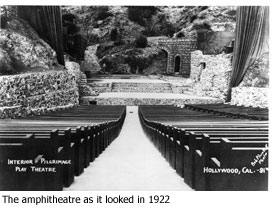 Also on the Ford’s wish list for the master plan: building new rehearsal and office space, along with a year-round restaurant; expanding or upgrading the 1,200-seat amphitheatre and its companion 87-seat theater, [Inside] the Ford; creating a sound barrier so that both venues can host performances simultaneously, and incorporating new environmentally-friendly technology throughout the site.
Also on the Ford’s wish list for the master plan: building new rehearsal and office space, along with a year-round restaurant; expanding or upgrading the 1,200-seat amphitheatre and its companion 87-seat theater, [Inside] the Ford; creating a sound barrier so that both venues can host performances simultaneously, and incorporating new environmentally-friendly technology throughout the site.
Levin & Associates Architects, which has worked on renovating and redefining a number of Los Angeles’ highest profile landmarks—including the Griffith Observatory and the Bradbury Building—has been selected to develop the master plan. The first big meeting on the project is scheduled for Thursday, with a goal of completing the plan by the end of the year. The planning is being funded by a $350,000 grant from the office of Supervisor Zev Yaroslavsky. The overall budget for rehabbing and rethinking the Ford will depend on what the master plan comes up with.
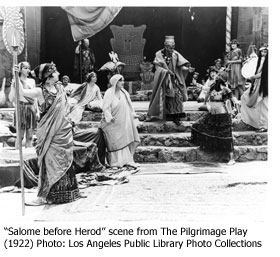 The master plan project is getting underway as the Ford turns 90 this year. Or to put that in Hollywood terms: it was time for a little work.
The master plan project is getting underway as the Ford turns 90 this year. Or to put that in Hollywood terms: it was time for a little work.
“It’s a pretty magical place when you walk into it,” Davis says. But he yearns for a “point of entrance, a point of arrival” for the Cahuenga Boulevard amphitheatre site, located just a short hop across the 101 Freeway from the internationally famous Bowl.
Davis is exaggerating—but only a little—when he says: “If I had a nickel for every person who told me ‘I never knew this place existed, and I’ve lived here all my life,’ I could have funded the master plan.”
An LED sign for the Ford was installed on Cahuenga last year.
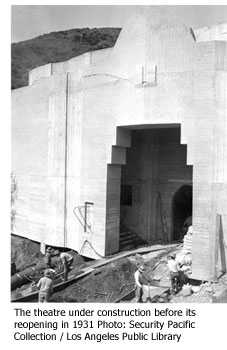 But “it’s still a hidden gem,” says Arts Commission Executive Director Laura Zucker who, with then-Supervisor Ed Edelman, helped build the modern-day Ford into a local arts institution in the early 1990s. “If you know, you know. If you don’t know, you can’t see it from the road.”
But “it’s still a hidden gem,” says Arts Commission Executive Director Laura Zucker who, with then-Supervisor Ed Edelman, helped build the modern-day Ford into a local arts institution in the early 1990s. “If you know, you know. If you don’t know, you can’t see it from the road.”
As it stands now, even people who can find the venue turn in and find themselves immediately facing “a parking lot and a blue motel,” Davis says. (The ‘60s-era one-time motel now provides office space for Davis and other members of the Ford staff, as well as for employees of the L.A. Philharmonic.)
The master plan aims to build on a series of improvements the county has undertaken at the Ford since 1999. Those improvements, totaling more than $6 million, include a $1.2 million electrical renovation; new signage and sound consoles; remodeling the box office, concession area and restrooms; and adding new picnic plazas, an ADA-compliant pathway and an elevator to make the steep terrain accessible to more people.
The master plan effort takes a longer, broader view of the facility. “It’s gotten to the point where we can’t piecemeal it anymore,” Davis says. “I’m so grateful that the county wants to invest in the place. It’s now important to plan not just for the next summer but for the next 30 years, 40 years.”
It was 90 years ago that the first theater on the Cahuenga Pass site was built by heiress and landowner Christine Wetherill Stevenson. Stevenson, who also led a group that acquired the property the Hollywood Bowl now sits on, created the venue as a setting for her “Pilgrimage Play”—a pageant she wrote about the life of Jesus. Stevenson’s production was “a highly attended event throughout the 1920s,” according to an art commission history of the locale, which notes that after the original theater burned down in a 1929 brush fire, the community rallied to rebuild it in its current form in 1931.
The land was deeded to the county in 1941, and the “Pilgrimage Play” was performed there until 1964, when factors that included a legal challenge to staging a religious show on county property shut down the production, according to another arts commission history of the site.
The setting is now a county regional park and the amphitheatre bears the name of the late County Supervisor John Anson Ford, an early proponent of fixing up the dilapidated facility. The launch of “Summer Nights at the Ford” in 1993 inaugurated the facility’s modern era as a venue for an eclectic mix of locally-based entertainment ranging from dance and music to theater and film. (This year’s summer schedule is here.)
“The theater’s been around since the 1920s, but we’ve only been programming it for 17 years,” Davis says. In that sense, he says, “we are a teenager.” And the master plan’s goal, in part, is to help the Ford answer the question, “What do we want to be when we grow up?”
Posted 5-05-10
Bring mom and make it a family circus
May 3, 2010
Lexi Pearl ran off and joined the circus. But she never really left home.
Growing up in Topanga Canyon, young Lexi did her share of the usual kid stuff—soccer, gymnastics, tree-climbing.
A lot of tree-climbing.
“It’s as if she was born to fly,” her mom recalls.
Make that born to fly, dance, choreograph, act and stilt-walk. Not to mention a few other gifts listed in the “special skills” section of her professional resume: Animal Handler, Archer, Circus Performer, Fencer, Gymnast, High Falls 10′ to 50′, Horseback Rider, Physical Fitness Expert, Sword Fighter, Yoga.
Now some of those skills, along with some others she’s honed over the years as a professional dancer and performer, are about to come into play as part of her own uniquely Topangan tradition—the Mother’s Day show at the Will Geer Theatricum Botanicum.
Pearl’s production, called “Momentum Place: An Uncommon Afternoon of Dance and Delights,” has evolved since its first staging 12 years ago, when Pearl was a senior at UC Santa Barbara and looking for a place for her student dance company to perform in L.A.
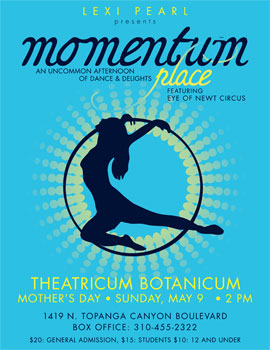 Last year, the annual performance landed on Mother’s Day and voila—a new local ritual was born. (And really, on a day largely devoted to flowers, candy and brunch, what mom could resist a chance to check out the Eye of Newt Circus instead?)
Last year, the annual performance landed on Mother’s Day and voila—a new local ritual was born. (And really, on a day largely devoted to flowers, candy and brunch, what mom could resist a chance to check out the Eye of Newt Circus instead?)
Like Pearl herself, the show is kind of unclassifiable.
“There’s nobody like her,” says Ellen Geer, the Theatricum’s artistic director and daughter of its founder, the actor Will Geer (perhaps best known to most of America as “Grandpa Walton.”) “When people come forth with such talent as she has, it must be seen.”
“You get acrobats spinning from the trees on pieces of silk, doing things you only thought you’d see in comic books,” says Matt Van Winkle, the Theatricum’s office manager and educational programs assistant, who ran sound for last year’s show and expects to be playing the guitar this time around.
“It’s cool. I guess a good word for it is panoply—a panoply of artists working in all of their different fields: dancing, acrobatics…”
Pearl says she expects to assemble about 25 “dancers, aerialists, singers, spoken word artists, actors, musicians, stilt-walkers [and] jugglers” to take part.
“It always kind of comes together the day of the show,” says Pearl, who’s currently in the midst of a 10-day stint as a stilt walker at the Huisten Bosch theme park in Japan.
Pearl, 35, now lives in Carthay Square with her boyfriend and fellow performer J. Kilgore (“He’s an actor; I dragged him into the circus world.”) But she says that coming of age in Topanga provided a strong creative grounding for her frequently airborne career.
“Growing up in Topanga was a huge aspect of developing my creative character,” she says, lamenting the fact that she’s had to miss even an occasional Topanga Days over the years. “It’s heartbreaking,” she says.
She also cherishes a long-running connection with the open-air Theatricum, where over the years she has taught in the summer camp, choreographed a production of “Dracula,” acted in “The Three Sisters” and played Puck in “A Midsummer Night’s Dream.”
“I’ve been part of the company there since I was a youngster,” Pearl says.
Performing runs in the family. Her late father, Robert Pearl, and her grandfather, Frank Everhart, were magicians, and her mother, Karin Woodward, is a former actress.
Woodward, a longtime Topanga resident, says her daughter was an active child who took full advantage of growing up in a place she describes as “a little hometown on the edge of this megalopolis.” 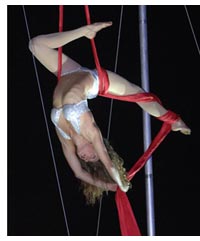
As she watched Lexi clamber up all those trees, “I knew she’d find her own path,” Woodward says.
But perhaps not one she expected.
“Never in a million years would I have thought ‘I want my daughter to be dangling 100 feet in the air on red silk,’ “ Woodward says. “But I love it. It’s thrilling.”
For Pearl, the hometown show offers an annual touchstone—a creative reflection of “where I’ve been and who I’ve met” over the course of the preceding year.
It’s also a chance to live out her professional credo. “My favorite saying is: As an artist, I get to create a tangible experience out of the invisible,” she adds.
And as for the show’s Mother’s Day tie-in, that, too, seems an appropriate reflection of Pearl’s life and times. “All of my girlfriends from 1st grade are having babies!” she says.
Then there’s the influence of her own mom.
“She has completely encouraged and facilitated my creative spirit,” Pearl says. “She’s been in the audience of every show I’ve ever done.”
Guess where she’ll be on May 9th?
The show takes place at 2 p.m. General admission tickets are $20; more information is here.
Posted 5-03-10
Hollywood Bowl Rolls Out 2010 Summer Season
April 23, 2010
If it’s summer, it’s the Hollywood Bowl.
This year’s amazing lineup kicks off June 18 with an Opening Night Gala to benefit Music Matters, the LA Philharmonic’s fund for musical education. That evening, the 2010 Hollywood Bowl Hall of Fame inductees will be disco queen Donna Summer, The Carpenters and classical pianist Jean-Yves Thibaudet. Hosting the evening will be legendary musician/composer/producer Herb Alpert.
Like every summer, the Bowl will bring you some of the biggest names in music, including Sting, Herbie Hancock, Smokey Robinson, John Mayer, The Dave Matthews Band, Harry Connick Jr., Lee Ritenour and Dave Grusin—and, of course, the Philharmonic’s own superstar, Gustavo Dudamel, who, among other things, will conduct the opera Carmen.
Other highlights of the summer season include the traditional July 4th Fireworks Spectacular with Vince Gill, the return of Wednesday night “Jazz at the Bowl” and Sunday Sunset Concerts, which will feature a special Beatles Celebration marking the 45th anniversary of the Fabs’ visit to the Hollywood Bowl.
Here’s the Hollywood Bowl ticket page. See you there!
Posted 4/23/10
Teen tragedy, set to music
March 24, 2010
Eli Villanueva is driving with his girlfriend in Burbank when they come upon two people on a bridge over the 5 Freeway.
The young man looks ready to jump. The young woman beside him is trying to restrain him.
“She was desperate. She was hysterical and really trying to hang on,” Villanueva remembers. “I had stopped the car and went over to see if I could offer some assistance…As I get there, the young man sees me.” Villanueva reaches out, clasps the young man’s hand and helps pull him back from the brink.
That split-second, adrenalin-pumping moment of human contact took place two years ago. Earlier this month, Villanueva felt those emotions rush back, confronted again with the traumas of youth in a different and unexpected context.
As resident stage director for LA Opera’s education and community programs, he was at work on an unusual project to turn poetry by teens in Central Juvenile Hall into songs to be performed by opera singers. He’d come across a poem called “Safe.”
Something that seemed like an ordinary day
Started off as promising but ended wrong in every way
Driving pretty fast in my Mercedes goin 80
As I come along the bridge and see a
young girl on a stump going crazy,
steppin to the edge while rocks are tumblin
off the road, and as I read the sign ahead
we’re 200 ft in the air is what I’m told.
Using my first mind I got out of the car
and started preachin. Next thing I know
I’m walking towards a person and I’m reachin.
My hands extended, my tears on edge,
all I can do is pretend that this person
is not my baby sister, about to reach her end…
“Safe,” with music by Villanueva and lyrics by a girl known to him only by her age and housing unit, gets its world premiere Friday. It’s one of four original songs to be performed at a Central Juvenile Hall “writers retreat” featuring the unlikely pairing of LA Opera and InsideOUT Writers, a nonprofit program that teaches creative writing to kids in L.A. County’s juvenile hall system.
It’s an improbable partnership but maybe not such a stretch.
“Here are the central themes of these kids’ lives: violence, death, guns, gangs, dead homies, beloved mothers, absent fathers…Tragedy. Which is perfect for opera,” says Sheri Lin, writing program director at InsideOUT.
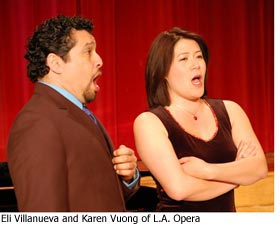 For the opera collaboration, Lin selected 11 poems written by students in 2008 and 2009. Villanueva ended up setting four of them to music.
For the opera collaboration, Lin selected 11 poems written by students in 2008 and 2009. Villanueva ended up setting four of them to music.
From the beginning, “Safe” stood out.
“That one affected most of us when we read it,” Villanueva says. “When I read it, I was actually a little bit afraid of it”—particularly about the challenge of capturing the 18-year-old girl’s perspective that is essential to the piece.
“It takes you on an arc,” he says. “It’s light at first. It’s lilting. And then from there, it doesn’t get violent, it doesn’t get tragic–it actually becomes sympathetic and touching and quite still.”
Then there was “If I Played My Song Backwards,” written by a 17-year-old boy.
“When I first read it, I said this is already a song,” Villanueva says.
If I played my song backwards I’d get—
a life
a love
& new best friends
a dog
a boy
The song never ends
a mom
her mom
the loves of my life
my moe
my truck
I’d feel all my strife
my bro
my school
how I miss these days
my lungs
my health
my life’s gone a blaze
my barbies
my binky
The days left unheard
That’s what you’d get when you play my song backwards.
Those words conveyed longing and regret—and like the other poems, seemed to offer a transcendent message for Villanueva to set to music.
“I’m really trying to relate to the moments which they are describing,” Villanueva says. “Some of these things that they are feeling can be quite universal…Sometimes what I read will bring up pictures in my own life.”
It would have been easy to verge into rap or beatbox stylings. But Villanueva took another musical route, channeling “a French-flavored waltz” in “If I Played My Song Backwards,” for example.
“If you played the melody with an accordion,” he says, “you’d be in Paris.”
“What my hope was to take the words that they came up with to see if I could translate them in an artistic way–but not too far away from what I thought would connect with them,” he says. “Not too artsy-fartsy.”
Villanueva didn’t just write the music; he’ll perform at Juvenile Hall on Friday, along with soprano Karen Vuong and pianist Daniel Faltus.
Also on the program are some classics from the operatic and musical theater, such as the “Largo al factotum” from Rossini’s “Barber of Seville” and “La chi darem la mano,” a duet from Mozart’s “Don Giovanni.”
And that will almost certainly be a first for most in the audience, Lin says.
“I’m sure a lot of the kids are not going to know what opera it is,” she says. But “they’re going to take a kid’s writing and set it to music. That’s going to ensure a connection.”
“My hope is that it will be this phenomenal experience for everybody involved,” she adds. The Juvenile Hall kids “are the tragedies of our society today. Their stories need to be heard. This is a medium for their stories to be heard.”
The marriage of opera and InsideOUT originated with philanthropist Eva Stern, who’s underwriting the Juvenile Hall program.
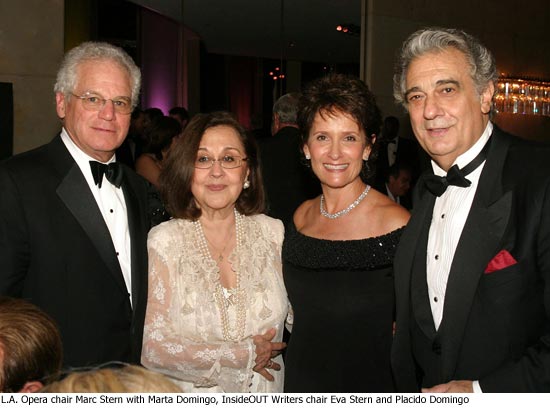
As the wife of LA Opera chairman and CEO Marc I. Stern (“He’s the opera lover; I’m the opera liker”), Eva Stern is no stranger to black tie galas and hobnobbing with the likes of Plácido Domingo, the opera’s general director.
But she’s also the chair of InsideOUT’s board, and serves on the board of organizations including the Center Theater Group’s education committee and Alliance Charter Schools. So she’s seen first-hand the power of exposing children to fine art, whether it’s a field trip to “Frost/Nixon” at the Ahmanson or a visit by opera singers to the Stern Math and Charter School on the campus of Cal State LA.
“These are kids who won’t even have heard of ‘Westside Story,’ ” Stern says. “It’s not about making them opera lovers; it’s giving them exposure to something. Any vehicle is the right vehicle if it is done keeping the audience in mind.”
And if this particular mash-up shatters some preconceptions, so much the better.
“Considering that the world thinks of opera as very high brow,” Stern says, “it’s important to know that opera is out there in the community and educating.”
Posted 3/24/10
Cue applause for Music Center Bravo Awards
February 25, 2010
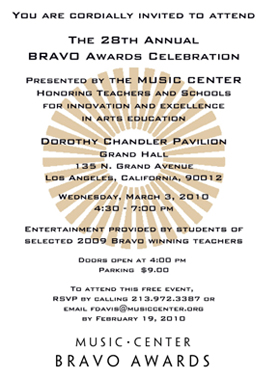 L.A. is widely known as a Mecca for aspiring performers from all over the world, but the region can also field an impressive roster of up-and-coming homegrown talent. Since 1983, as part of the Music Center’s arts outreach and education program, the annual Music Center Bravo Awards, to be held Wednesday, March 3 at the Music Center’s Dorothy Chandler Pavilion, honor distinguished teachers and schools for excellence in the arts. Out of 38 eligible nominees this year, the Music Center will present three BRAVO Awards — one to a general classroom teacher, one to an arts specialist and one to a school – with winners receiving a cash award and a specially commissioned BRAVO sculptured trophy.
L.A. is widely known as a Mecca for aspiring performers from all over the world, but the region can also field an impressive roster of up-and-coming homegrown talent. Since 1983, as part of the Music Center’s arts outreach and education program, the annual Music Center Bravo Awards, to be held Wednesday, March 3 at the Music Center’s Dorothy Chandler Pavilion, honor distinguished teachers and schools for excellence in the arts. Out of 38 eligible nominees this year, the Music Center will present three BRAVO Awards — one to a general classroom teacher, one to an arts specialist and one to a school – with winners receiving a cash award and a specially commissioned BRAVO sculptured trophy.
Posted 2/25/10
Multi-million dollar loan has LA Opera singing a happy aria
December 8, 2009
The operatic repertoire is full of passion, suspense and dizzying turns of fortune—kind of like what’s been going on at LA Opera, which is fending off financial uncertainty even as it gears up for its most ambitious year ever.
Los Angeles County stepped onto center stage in the hero’s role on Tuesday, guaranteeing a $14 million loan to keep the opera afloat.
“We are absolutely thrilled that the County of Los Angeles has recognized the important and prestigious role that a world-class opera company plays in our community,” said Plácido Domingo, LA Opera’s general director. The board’s support, he said, “will enable us to continue as a prominent and vital element in the cultural life of Los Angeles and in furthering this region’s stature as an international cultural center.”
The cash infusion will keep the opera going through June, 2012, when the company expects to repay the loan from more than $30 million in pledges made since June by donors responding to the opera’s urgent fundraising plea.
“They’re passionate and they put their money where their mouth is,” Supervisor Zev Yaroslavsky said of opera fans. As a result, the new financing arrangement carries “very minimal risk,” Yaroslavsky said, adding that the alternative simply is unacceptable. “This is one of our major tenants at the Music Center,” he said. “If they go, it sets off a chain reaction of events that could topple the Music Center.”
The financial crisis, coming at a crucial time in the 25-year history of the LA Opera, is not unique to this company, said Music Center CEO Stephen D. Rountree, who during the past year has also been serving as LA Opera’s chief financial officer. “Opera companies are always pressed but [LA Opera] had their operations in order until the recession hit,” Rountree said. “Ticket sales are down across the country.”
For example, the Washington National Opera, which also has Domingo as general director, recently announced cutbacks in staff and programming.
The LA Opera also has been scrambling to dig out of its deficit, cutting staff by 20% and administrative costs by 22%, Chief Executive Officer William Fujioka said in his letter to the board. “It also reduced the number of productions in its 2008-2009 season from 9 to 6, and gave fewer performances—48, instead of 67.”
Fujioka said the new loan arrangement “does not put the county in jeopardy whatsoever.” The county will issue bonds that will be purchased by a single financial institution, Banc of America, Leasing & Capital, LLC, which will then provide the money to LA Opera. The county itself is not putting up any cash but is guaranteeing the loan in the unlikely event that the opera’s anticipated donations fall through—something opera and county officials say as highly unlikely.
Rountree said that having Domingo—“the leading spokesman for opera in the world”—in Los Angeles, has proved invaluable in raising the donations. The county stepped in to assist in a similar manner during the construction of Disney Hall, until private donations could bridge the funding gap.The opera company, whose musical director is James Conlon, is gearing up for performances in June of the Ring Cycle, the four operas that comprise Richard Wagner’s “Der Ring des Nibelungen.” The operatic masterwork is at the heart of the 10-week Ring Festival LA, which begins next April and is expected to draw international attention with its broad range of musical performances, art exhibits and seminars.
And on that point, art is poised to triumph over money.
Making a joyful noise
November 1, 2009
The fireworks cascading above the Hollywood Bowl have died down. So, for the moment, has the roar of Gustavo-mania that has greeted the arrival of the Los Angeles Philharmonic’s charismatic new conductor, Gustavo Dudamel. But in a small practice room on the second floor of a building next to the 1932 Los Angeles Swim Stadium, something is burning bright.
It’s a weeknight, just before Halloween. Paloma Udovic, 28, is heading into her fourth straight hour of teaching here at the Expo Center near USC, where her organization, the Harmony Project, is part of a unique collaboration with the Los Angeles Philharmonic and the city Department of Recreation and Parks. She’s upbeat and gently welcoming as the viola section files in: Cathy Gomez, Claudia Tinajero, and the Pinto-Quintanilla sisters, Amy, 10, and Arian, 13. The Pinto-Quintanillas are a force to be reckoned with around here—a third sister, 16-year-old Adria, also plays cello in the orchestra.
While the Pinto-Quintanilla family trifecta is notable (“I think that’s the record,” Udovic says), it’s hardly unusual.
There’s an infectious energy that seems to pull everybody—brothers, sisters, parents, grandparents, cousins—into the vortex of Youth Orchestra Los Angeles (YOLA), an ambitious and growing program modeled on Venezuela’s legendary El Sistema, whose most famous alum just happens to be that cool new guy on the podium at the Phil.
YOLA isn’t an orchestra per se. Gretchen Nielsen, the Phil’s director of educational initiatives, describes it as a movement to establish youth orchestras in under-served communities. “When you do something this intensively,” she says, “you’re building a sense of community, a sense of family. These kids don’t have easy lives. A lot of them are taking care of siblings, or come from broken homes…If they’re late for class, you ask what’s going on, but you don’t scold.”
It all started when a Los Angeles Philharmonic delegation visited Venezuela to observe El Sistema in 2007—back when the notion of landing Dudamel as the orchestra’s music director was still under wraps. “That trip kind of opened everyone’s eyes,” Nielsen says.
“What happened in Venezuela had to happen here.”
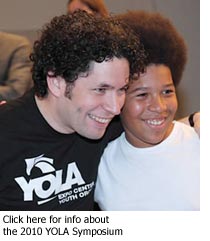 The YOLA EXPO Center Youth Orchestra program is the first such venture, but it won’t be the last. With 200 students ranging in age from seven-year-olds to teenagers now playing in two orchestras at Expo, the Phil is planning to add another site next year, on its way to yet another by 2013, serving a total of 1,000 students.
The YOLA EXPO Center Youth Orchestra program is the first such venture, but it won’t be the last. With 200 students ranging in age from seven-year-olds to teenagers now playing in two orchestras at Expo, the Phil is planning to add another site next year, on its way to yet another by 2013, serving a total of 1,000 students.
The Expo Center kids were a focal point of the huge free concert at the Hollywood Bowl that inaugurated the Dudamel Era in Los Angeles.
More than a month later, everybody who was there is still saying the words “October Third” like somebody might say “The Fourth of July”—a holiday, a triumph, a date that will live in ecstasy.
“I thought it was going to be a really big thing. It was even bigger than that, especially when Jack Black came on,” says 13-year-old Arian Pinto-Quintanilla, a student at Palms Middle School in West L.A. “We stayed for the fireworks. Everything was, like, movie-ish.”
As for Dudamel, “he treated us as if we were his actual orchestra.”
Which, in a sense, they now are.
At the rehearsal for the Hollywood Bowl concert, Dudamel, wearing jeans and a black T-shirt inscribed with “YOLA” and “Expo Center Youth Orchestra,” is a natural, encouraging and funny as he leads the students through an arrangement of Beethoven’s Ode To Joy.
He cracks them up. “Violins, I can see you play but it’s so boooooring.” He asks the cellists if they’re a bunch of 85-year-olds. He makes them sing. He precedes a downbeat by counting in Spanish: “Uno, dos, tres, y….”
He’s helping them see their youth as an outrageous power source, something that can help them play—and be—bigger. “What is the size of our instrument?” he asks the cello section. “Is it like this?” he says, indicating tiny. “Or like THIS?”—arms spread wide.
Ode to joy, indeed.
Star-studded concerts at the Hollywood Bowl are one thing. The hard slog of day-in, day-out practicing is another.
Expo Center orchestra students have three nights of group sectional lessons every week and a full orchestra rehearsal on Saturdays. Some, like the Pinto-Quintanilla girls, play in more than one orchestra.
But, amazingly to anyone who ever resisted piano lessons or been pushed into patent leather shoes and paraded into a symphony hall against their will, the YOLA/El Sistema method actually seems…fun.
“It’s very different from the teaching I’ve done where the parents are forcing them,” Udovic says. Here, at the Expo Center, “it’s the other way around.”
For the kids, part of the appeal has to be the pure play of it all. Before the viola sectional that the Pinto-Quintanillas take part in, the violins have their turn.
A little girl in a sparkling white-and-silver costume floats around the room playing “Invisible String Master,” poking backs, correcting wrist positions, delicately but insistently making her compatriots look more like, well, real violinists.
The informal mood continues into the viola sectional.
“Can we make sure our booties are scooted all the way to the front of the seat?” Udovic urges.
Udovic asks whether the scale they just played was in tune. One of the girls admits she wasn’t listening.
“Listen,” Udovic tells the girls, imparting life wisdom as well as musical advice. “It’s not just in music. It’s in lots of other things. It’s a good thing to do.”
“I view this as a social program, with music as the mode,” says Udovic, 28, a Northwestern grad and self-described “Suzuki baby” who picked up her first violin at age 3. She’s part of a cadre of more than a dozen “teaching artists” on the program staff, working musicians with a gift for instructing young people and an interest in social progress.
Mirna Quintanilla, a medical assistant in Beverly Hills, is the mother of Adria, Arian and Amy—her “three A’s,” she says. Those letters aren’t just initials: “That’s what I tell them for the grades. Only A’s.”
After getting divorced, Quintanilla says, “my priority was to keep them busy.” There were art classes and music, lots of it. They haven’t looked back. “We are busy seven days a week,” she says. Even though they log a lot of miles from their home near the Expo Center (the program aims to serve kids living within a 5-mile radius), you won’t hear her complaining.
“I don’t mind,” she says. “My priority now is my three daughters.”

At left, Amy Pinto-Quintanilla, 10, practices the viola. Her sister, 13-year-old Arian Pinto-Quintanilla, right, plays viola, too. Both also play the violin.
The Expo Center program is free, as are the instruments. “To pay for these classes, we could not afford it,” Quintanilla says. And the results: priceless—like having your daughters perform at the Bowl, under the direction of Dudamel. “I invited all my friends,” Quintanilla says. It wasn’t until the next day that the accomplishment actually sunk in for her daughters: “We played in the Hollywood Bowl.”
Beyond the thrill of such moments, the program derives much of its power from its commitment to spreading its mission and methods around the world.
Dudamel’s mentor, El Sistema founder Dr. José Antonio Abreu, won a 2009 TED award and is using the $100,000 prize to endow the Abreu Fellows Program at the New England Conservatory of Music. Abreu fellows will perform internships at El Sistema-inspired “nucleos” across the U.S.; some will be at Expo Center this spring.
Also in the works: a program developed with USC’s Musical Education Department to begin bringing early childhood music classes to the 3- to 5-year-olds in the Expo Center preschool starting in January.
The Colburn School, across from Disney Concert Hall in downtown Los Angeles, also is getting in on the act with the Colburn Mentorship Program, in which 20 conservatory students will be paired with 20 Expo Center students for one-on-one lessons.
Abreu, in town for the Dudamel debut concerts, recently dropped by the Los Angeles County Hall of Administration to pay a visit to County Supervisors Zev Yaroslavsky and Gloria Molina, along with Philharmonic President and CEO Deborah Borda.
They talked about Abreu’s now-famous observation that children who hold hold instruments can’t hold guns, and recalled the advice he gave Borda when they talked about importing El Sistema to L.A. “Think big but start small.”
The advice now: “Grow without fear.”
LA Opera Announces Wagner “Ring Festival” For Los Angeles
November 11, 2008

On November 3, 2008 Supervisor Zev Yaroslavsky joined Placido Domingo, General Director of the LA Opera, and other officials to announce the “Ring Festival,” a major Countywide arts and culture extravaganza planned for 2010 to celebrate LA Opera’s presentation of Richard Wagner’s Ring Cycle. Events will include exhibitions, performances, symposia and special events developed for the occasion, which will mark the first time that Wagner’s four-opera epic work will be presented in its entirety in Los Angeles. A wide variety of venues will host events throughout Southern California from April 15 through June 30, 2010.
“We can all be proud that so many diverse organizations are joining together in this incredible effort,” Yaroslavsky said. “Ring Festival LA will highlight the wealth of arts and culture that is unique to our town. The festival puts Los Angeles at the forefront of our major international cultural destinations, drawing together visitors from around the world and residents from neighborhoods across our county. It’s truly a celebration for all of us.” Visit LA Opera Ring Festival for full details.




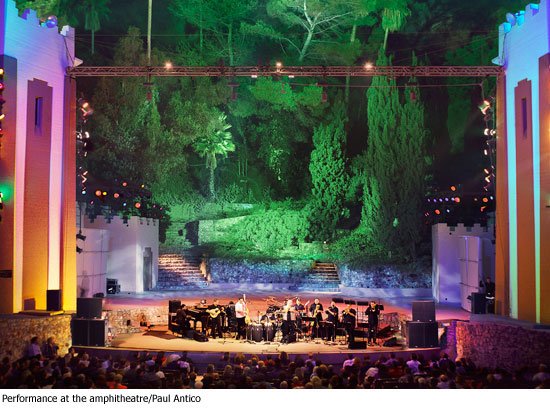
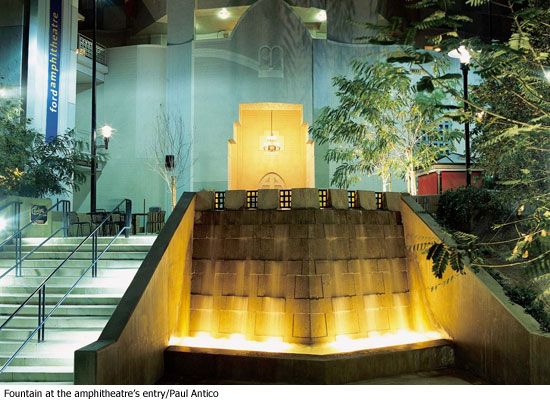

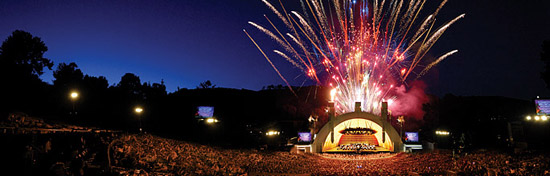
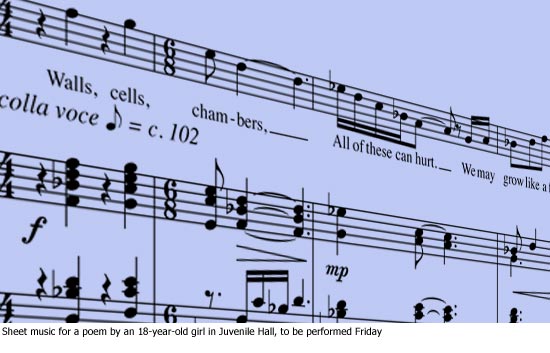
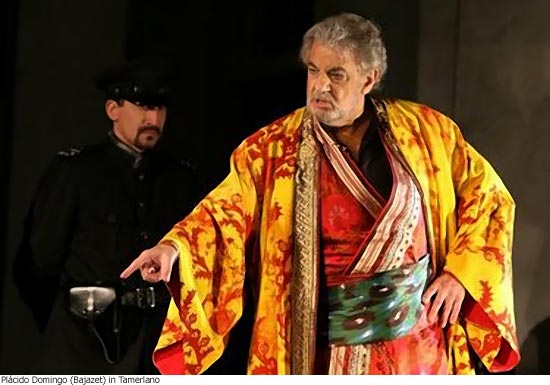
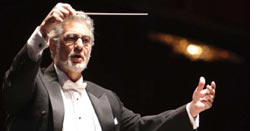
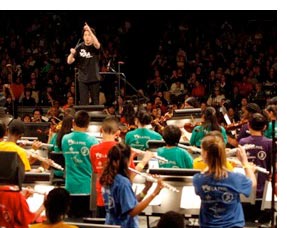
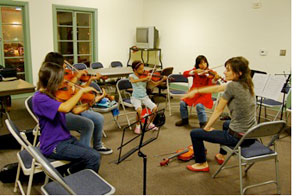









 405 bridge work causes a stink
405 bridge work causes a stink